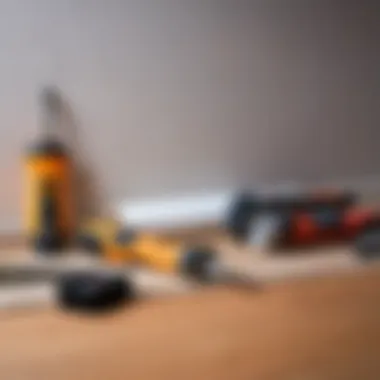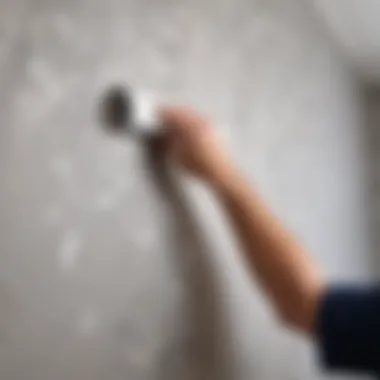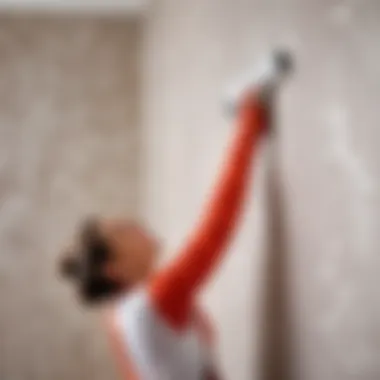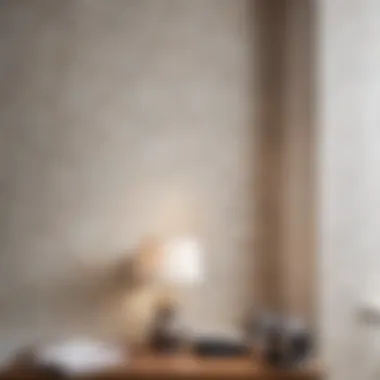Fast and Effective Wallpaper Application Guide


Intro
In the realm of home improvement, wallpaper application emerges as a transformative technique to refresh interiors. This guide focuses on the essentials of quickly applying wallpaper in a room. It outlines the preparations, required tools, and effective techniques that ensure a smooth application process. By following this guide, both novice and seasoned DIY enthusiasts can achieve a professional look with relative ease.
Проектирование и планирование
Как выбрать проект для DIY
Before starting, it is crucial to select the right wallpaper design. Consider the atmosphere and purpose of the room. For a calm space such as a bedroom, softer patterns or colors might work well. In more social areas like the living room, bold patterns can create an inviting atmosphere. Browsing through magazines, online platforms, or visiting local stores can provide insight into trending designs.
Оценка времени и ресурсов
Planning the timeline for the project is necessary. Applying wallpaper can take anywhere from a few hours to a full day depending on the project size. Consider the following elements:
- Measurement of the walls
- Preparation of the surface
- Mixing adhesive or applying pre-pasted paper
Evaluating resources is also important. Gather all required tools before starting to ensure efficient workflow.
Выбор материалов
Типы материалов для различных проектов
Selecting the right wallpaper material is imperative for a successful application. Various materials cater to different aesthetics and durability needs. The primary options include:
- Vinyl Wallpaper: Often used in high-moisture areas due to durability.
- Paper Wallpaper: Offers a wide range of designs but lacks moisture resistance.
- Fabric Wallpaper: Adds texture but may require more care during installation.
Understanding the project scope will guide material selection.
Советы по покупке и экономии
When purchasing wallpaper, consider bulk buying from reputable suppliers to get discounts. Look for online sales or clearance sections where you can find quality materials at reduced prices. Additionally, choosing wallpaper that does not require extensive matching can save time and reduce waste during application.
“Proper preparation prevents poor performance.” - An often essential principle in DIY projects, ensuring that every step aligns for a seamless finishing touch.
In summary, the right planning and material selection lay the foundation for a quick and effective wallpapering process. By understanding the available options and thoroughly preparing, the daunting task of wall decoration becomes achievable.
Intro to Wallpaper Application
Wallpaper application is more than just a way to cover a wall; it is a significant part of interior design that can dramatically influence the aesthetics of any space. Understanding how to apply wallpaper quickly and effectively is essential for anyone embarking on a home improvement project. This article will provide a comprehensive guide that encompasses the initial preparations, the tools necessary, the techniques for swift application, and the care required afterward. Wallpaper can transform a mundane room into a noteworthy space, and knowing how to apply it properly plays a crucial role in ensuring a successful outcome.
Importance of Wallpaper in Interior Design
Wallpaper serves as a powerful tool in the realm of interior design. It establishes a room’s mood, character, and style. The right wallpaper can bring life to otherwise bland spaces, acting as a focal point or a subtle enhancement, depending on the choice made. Various patterns and textures can be used to create depth and interest, moving away from the traditional painted wall.


Commonly, designers leverage wallpaper to express personal style and preference. It can be the defining element in a room, affecting how colors are perceived and how lighting interacts with various surfaces. Moreover, wallpaper not only adds beauty but can also provide practical benefits, such as sound absorption and thermal insulation. Therefore, understanding its significance amid contemporary design trends is indispensable for any DIY enthusiast or professional in the field.
Understanding Different Types of Wallpaper
When it comes to wallpaper, knowledge of the specific types available is key to making informed decisions. Each type presents unique characteristics, advantages, and installation methods. Some common types include:
- Vinyl Wallpaper: This type is durable and easy to clean, making it ideal for high-traffic areas like kitchens and bathrooms.
- Non-woven Wallpaper: Known for its breathable properties, this wallpaper is easier to apply and remove without damaging the walls beneath.
- Fabric Wallpaper: This option is luxurious and often used in formal settings, but it may require more maintenance.
- Paper Wallpaper: Traditional and varied in design, it is usually less expensive but may not be as durable.
Selecting the right type of wallpaper based on the room's functionality and design aspirations is crucial. Understanding the differences ensures that the chosen wallpaper enhances the space effectively while also providing long-lasting results.
Preparing Your Room for Wallpapering
Preparing your room for wallpapering is a crucial step that can greatly influence the outcome of your project. This phase sets a solid foundation, ensuring the wall is ready to adhere effectively to the new wallpaper. Without proper preparation, even the most beautiful wallpaper can end up looking unappealing or be prone to damage.
Key elements of preparation include creating a clutter-free environment, evaluating the wall's condition, and selecting the appropriate wallpaper. Each of these steps plays a significant role in the overall efficiency and final appearance of the wallpaper application.
Clearing the Space
The first part of preparing your room involves clearing the space. This means removing all furniture, decorations, and anything that may obstruct your work. A clear space enhances movement and reduces distractions while you work. It also minimizes the risk of damaging items or injuring yourself during the application process. If you cannot completely remove furniture, consider moving it to the center of the room and covering it with drop cloths.
Additionally, take this opportunity to clean your floor. Dust and debris can hinder your workflow, and starting with a clean slate is always advantageous.
Assessing Wall Condition
Next, it is vital to assess the condition of your walls. Check for cracks, holes, or peeling paint. These imperfections can affect how your wallpaper adheres. If you find any issues, they should be repaired before proceeding. Patching holes with spackle and sanding down rough areas can create a smoother surface. For painted walls, be sure to remove any loose paint as well.
Also, ensure that the surface is clean and free of grease or oil. A simple wash with mild soap and water will do. By ensuring that your wall is in excellent condition, you will allow your wallpaper to stick properly and stand the test of time.
Choosing the Right Wallpaper
Choosing the right wallpaper is a significant decision in the preparation stage. The wallpaper style should align with the room's theme and your personal preferences. However, functionality is equally important. Some wallpapers are more suitable for specific environments. For instance, vinyl wallpaper is ideal for high-moisture areas like bathrooms and kitchens. On the other hand, fabric wallpapers can provide a lush and sophisticated look but may require different care.
Consider the width and repeat of the wallpaper pattern, which will impact measurement and cutting. Opt for a wallpaper that complements the existing decor. Additionally, check the adhesive type when selecting your wallpaper. Some wallpapers come pre-pasted, while others need to be adhered with paste, so understanding the requirements is crucial.
In summary, preparing your room involves clearing it out, checking for any wall damage, and carefully selecting your wallpaper. Each step plays a crucial role in ensuring the wallpaper is applied smoothly and lasts long.
Tools and Materials Needed
Knowing which tools and materials are needed for wallpaper application is crucial for efficiency and effectiveness. Using the right equipment can significantly cut down the time required for the project and ensures a smoother finish. Each element has a role to play in the overall process, and without them, frustration may quickly arise. Hence, before the wallpaper is even unrolled, having everything at hand is important for a successful outcome.
List of Essential Tools
The success of your wallpapering project depends on the tools you utilize. Here is a list of essential tools you should gather before you begin:


- Tape Measure: Accurate measurements prevent excess waste and ensure your wallpaper fits perfectly.
- Level: Ensures your strips are straight, which is critical for aesthetics.
- Utility Knife: A sharp knife is necessary for cleanly cutting your wallpaper.
- Wallpaper Brush: Use this to smooth out bubbles and creases as you apply.
- Smoothing Tool: This helps to ensure there are no bubbles once the wallpaper is applied.
- Sponge or Cloth: Useful for wiping off excess adhesive and cleaning any surfaces.
- Step Ladder: Provides necessary height if you're working on tall walls or ceilings.
Having all these tools within reach will help you work more efficiently and effectively.
Materials for Wallpaper Application
Choosing the right materials for wallpapering is equally important. The materials you select directly influence the ease of application and longevity of the wallpaper. Here are key materials involved:
- Wallpaper: Many options exist, such as vinyl, paper, and fabric. Vinyl is often preferred for its durability and washability.
- Adhesive: Ensure you have the correct adhesive for your wallpaper type, whether it's pre-pasted or traditional.
- Primer: A good primer prepares your walls and can improve adhesion, leading to better results.
- Sealer: Sealing the edges can protect your wallpaper from moisture and damage.
Techniques for Quick Wallpaper Application
The application of wallpaper can often appear daunting, but utilizing effective techniques can streamline the process significantly. In this section, we will explore the methodologies that facilitate a quicker application while maintaining high quality. Understanding these techniques is crucial for achieving a professional-looking finish, reducing the likelihood of common errors, and ultimately enhancing your space efficiently.
Measuring and Cutting Wallpaper
Accurate measurement is the foundation of successful wallpapering. Begin by measuring the height and width of each wall. A laser level or measuring tape can help ensure that your measurements are precise. This information allows you to determine how much wallpaper is needed. Once you gather the correct measurements, proceed to cut the wallpaper. It is advisable to cut the wallpaper into manageable strips that are slightly longer than the wall height. This extra length will help compensate for any miscalculations during installation, allowing for adjustments if needed.
When cutting wallpaper, use a sharp utility knife or wallpaper scissors. Straight edges will help achieve clean cuts that fit neatly against the wall. You may consider using a cutting mat, which protects surfaces and enhances the safety of your work. Be careful not to pull the wallpaper too tight, as this can cause it to stretch and lead to complications during application.
Applying Adhesive to Wallpaper
The choice of adhesive can impact how quickly you can apply wallpaper. Most wallpapers either require paste or are pre-pasted. If you opt for traditional wallpaper, apply the adhesive evenly to the back using a paint roller or brush. Ensure that every inch is covered without over-saturation, as too much paste can lead to wallpaper buckling. For pre-pasted wallpaper, activate the adhesive per the manufacturer’s instructions by wetting the back.
While applying adhesive, it is essential to work in small sections, focusing on one strip at a time. This approach prevents the adhesive from drying before you can place the paper on the wall, which ensures an easier application process. Plus, fussing with overly large pieces of wallpaper can hinder your workflow.
Placing Wallpaper on the Wall
Carefully position the first strip of wallpaper onto the wall, starting at the top. Make sure to align it straight, as this will serve as the basis for the remaining strips. You can gently press the top and work your way down to eliminate air pockets. Using a wallpaper smoothing tool can help in this step. This tool assists in removing bubbles and ensures a firm bond with the wall beneath.
It's important to adjust the position as needed before the adhesive sets. Once you are confident in the placement, smoothen out from the center towards the edges. This technique ensures that the wallpaper adheres properly and looks seamless.
Aligning Patterns
If you choose patterned wallpaper, pattern alignment becomes essential for a cohesive look. Before applying, dry-fit the wallpaper strips against the wall to determine how the patterns align. Mark reference points on the wall lightly with a pencil or chalk to guide placement. This preliminary step saves time and minimizes the risk of having to reposition strips once the adhesive has been applied.
Additionally, always focus on aligning the first piece correctly with the pattern. Subsequent strips can then be more easily matched to this initial piece. This attention to detail enhances the overall aesthetic, ensuring that the wallpaper does not appear disjointed or inconsistent.
"Proper planning and execution are the keys to achieving a flawless wallpaper installation."
Handling Common Challenges
Applying wallpaper can be a rewarding project that enhances the aesthetic of any room. However, even with the best preparations, challenges may arise during the application process. Addressing these challenges is crucial to achieving a seamless finish and ensuring long-lasting results. If not handled properly, they can impact the overall appearance of the wallpaper and even lead to costly re-dos. This section discusses common challenges faced when wallpapering, focusing on how to effectively deal with bubbles, wrinkles, and misalignments. By understanding these issues, you can apply your wallpaper swiftly and efficiently, resulting in a professional look.


Dealing with Bubbles and Wrinkles
One of the most frequent issues encountered during wallpaper application is the presence of bubbles and wrinkles. These imperfections can disrupt the otherwise smooth surface of the wallpaper, making it look unprofessional. The cause of these bubbles can vary. Sometimes, they form if the adhesive isn't spread evenly. Other times, they result from air being trapped beneath the wallpaper during placement.
To deal with bubbles effectively, it is essential to address them immediately. Here are steps you can take to fix them:
- Use a Squeegee: Once the wallpaper is applied, use a smoothing tool or squeegee to push air bubbles towards the edges. This technique often resolves small bubbles.
- Puncture Method: For larger bubbles, use a fine pin to puncture the bubble. Apply gentle pressure to the area to push the trapped air out.
- Adhesive Reapplication: In some cases, you may need to lift the wallpaper slightly and reapply the adhesive in that area, ensuring better adhesion.
Correcting Misalignments
Misalignments can pose significant challenges during wallpaper application. When the patterns do not line up correctly, the overall look is disrupted. This can occur due to a variety of reasons, such as improperly measuring the wall or cutting the wallpaper incorrectly.
To ensure proper alignment, consider these strategies:
- Use a Level: A level can help gauge the straightness of your wallpaper. Always start from the corner, making sure your first panel is perfectly straight.
- Vertical Reference Line: Before applying the first piece, consider drawing a straight vertical line using a level or a chalk line. This will serve as a guide for aligning subsequent strips.
- Pattern Matching: If your wallpaper has a pattern, align the repeat of the design at the joints. This may require trimming the edges to achieve a seamless look.
Dealing with bubbles, wrinkles, and misalignments is crucial in the wallpaper application process. By knowing how to handle these common challenges, you can maintain a smooth workflow, leading to a successful outcome. There is an inherent satisfaction in overcoming these hurdles, which ultimately enhances both the appearance and durability of your wallpaper.
Post-Application Care and Maintenance
Proper care and maintenance of wallpaper after application is crucial for longevity and aesthetics. Many people overlook this phase, focusing solely on the application process. This oversight can lead to complications that diminish the visual appeal and durability of the wallpaper.
Allowing Wallpaper to Set
After hanging wallpaper, it is important to allow it to set properly. This phase ensures that the adhesive bonds securely with the wall. Immediate pressure or disturbances can disrupt this process and lead to issues like peeling or bubbling. Ideally, avoid heavy traffic in the room for at least 24 hours.
- Temperature Control: Keep the room at a moderate temperature. Extreme heat or cold can affect the adhesive's performance.
- Humidity Levels: Maintain appropriate humidity to prevent the wallpaper from drying too quickly, which can lead to uneven adhesion.
- Avoid Moisture: Keep the area dry. Excess moisture can weaken the adhesive and can lead to mildew growth behind the wallpaper.
Cleaning and Caring for Your Wallpaper
Routine cleaning is essential to maintain the wallpaper's appearance. Dust buildup can dull colors and patterns over time. Knowing how to clean wallpaper without damaging it is important.
- Gentle Dusting: Use a soft cloth or a duster to remove dust regularly, focusing on the edges where dust often accumulates.
- Spot Cleaning: For stains or marks, use a damp cloth. Test on a small area first to ensure no damage occurs. Avoid harsh chemicals, as they can fade colors or damage the material.
- Rinse Carefully: If you use any cleaning solution, rinse with water promptly to prevent residue buildup.
- Professional Cleaning: If wallpaper looks significantly worn or stained, consult a professional cleaner. They have specific products and techniques suited for different wallpaper types.
Incorporating these care tips can significantly enhance the lifespan and appearance of your wallpaper, allowing it to continue being a beautiful part of your space for years to come.
Epilogue
In this guide, you learned how to efficiently apply wallpaper, transforming your interior spaces effectively. Understanding the process equips you to not only enhance aesthetic appeal but also ensure durability and ease of maintenance.
Recap of Key Steps
As we wrap up, let us briefly revisit the critical steps involved:
- Preparing the Room: Clear your space and assess the wall’s condition before applying wallpaper.
- Selecting Materials: Choose suitable tools and high-quality wallpaper that fits your design vision.
- Applying the Wallpaper: Measure, cut, and adhere wallpaper precisely, paying close attention to patterns and alignment.
- Handling Challenges: Deal with common issues like bubbles and misalignments through good techniques.
- Post-Application Care: Let the wallpaper set and maintain it properly to ensure longevity.
Each of these steps is integral to a seamless application process, promoting a professional finish.
Encouragement for DIY Enthusiasts
Applying wallpaper may seem daunting initially, but with practice, it becomes a manageable project. Each session offers the chance to refine your skills, so don’t shy away from tackling designs. Embrace the challenge; your efforts will pay off in the end. You contribute to personalizing your space in ways that reflect your tastes. Engage with tutorials, join communities on platforms like reddit.com for tips and support, and most importantly, enjoy the transformation of your home as you conquer this skill. Your journey in DIY can be both rewarding and fulfilling.







